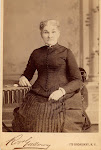
It is late winter 1851. Stephen and Elizabeth (Charnock) Walch have decided to immigrate with their family to America. Their move was most likely shaped by two outside forces: the concentration of Irish immigrants in the Liverpool area during the potato famine; and the development of inland railroads in Connecticut.
Immigrants where prohibited by English law to work in the skilled and trade occupations. This resulted in keeping the wages for unskilled jobs low, while at the same time creating a larger pool of English workers competing for skilled jobs.
In Connecticut, the early railroads were laid out along low land and coastal routes. Around 1850 railways were beginning to reach inland stone quarries that previously served only local needs. These quarries were now being developed to serve the demands of the booming New York and New England populations. Because skilled quarrymen were in short supply, recruiters were sent to England to find them.
The use of skilled immigrants served the quarries well. Emigrants typically signed a three to five year contract for passage and a fixed wage. With the continuing replacement of immigrant workers who fulfilled their contracts, quarry owners ensured a large competitive labor pool which would result in continued lower wages.
We cannot say for sure that Stephen Walch signed such a contract. But a large group of men on the ship he boarded were quarrymen who likely were signed by the same recruiter. So now that we know the Walchs have decided to go to America, let's find out how they got there.
Ship passage to America was perilous, particularly during the Irish immigrations of the 1840s. Unscrupulous ship owners crammed steerage class passengers into retrofitted cargo holds and cutback such amenities as adequate food and sanitary facilities. Because so many people died in passage, Parliament passed a series of laws in the late 1840s to regulate conditions aboard ships. The minimum allotment of physical space and other health concerns were regulated. All passengers had to have a physician’s certificate verifying that they were fit to travel. This resulted in physician’s opening offices at dockside to fulfill the need.
The Walchs were fortunate to have booked steerage passage on the ship Vanguard. The Vanguard was a packet newly built by William Webb, a respected shipbuilder who also built the Yorkshire “the fastest packet of her time." Originally, a ‘packet’ ship referred to a vessel used by Britain to deliver mail packets to and from its colonies and outposts. The term was later applied more generically to a class of vessels that were fast and reliable. The Vanguard was a 796 ton vessel captained by Master Parker B. Norton of Liverpool. And, while it was considered a good ship the Walchs may have known that during its last trip to New York five passengers died at sea and six were born. Travel to America was not a sure thing.
The Walchs’ date of departure was Wednesday, February 26, 1851. Passengers were allowed to board ships the night before and lined up to reserve a suitable spot for themselves in steerage. Steerage passengers were housed below deck, usually in and one or two large rooms. Women with children and older people usually shared a dormitory, while men shared another. Often the dormitories were only curtained off as were other sections like toileting areas. Berths were usually three tiers high. And, most passengers brought supplemental food, if they could afford it.
Friends and relatives usually gathered on the dock to say farewell. Often the goodbye parties went on through the night. But this was February, so the goodbyes may have been brief. This was a difficult time. Most people understood that this was the last time they would see their loved ones.
In the early morning after the Vanguard pulled away from the dock, all passengers were required to come on deck for a final health inspection by a government physician. While passenger inspection was taking place, the crew was busy below deck looking for stowaways. Stowaways and ill passengers were removed to a pilot boat before the Vanguard reached the open sea.
The ship’s manifest showed Elizabeth “Walsh”, 30, accompanying James, 3, and Margaret, one year old. There was no charge for children under 12 months old. Stephen “Welsh” is listed in the company of 131 quarrymen from England. Overall, there were 510 passengers on the Vanguard, including 18 children and seven first-class cabin passengers.
The Vanguard arrived in New York City on Monday, April 14, 1851. A New York Times article said that the Vanguard took 47 days to cross and "had light winds all the passage." After they arrived in New York, the Walchs may have taken the train or a coastal boat to their final designation -- Connecticut.
----------------------
If you want to get a sense for the dress and conditions of that period as well as the kind of welcome they may have received from New Yorkers, watch the movie “The Gangs of New York.”





No comments:
Post a Comment